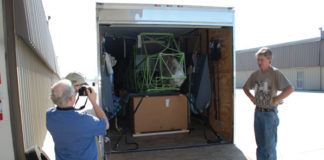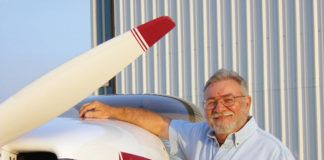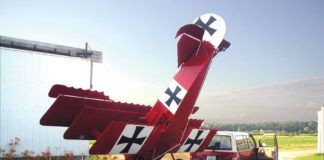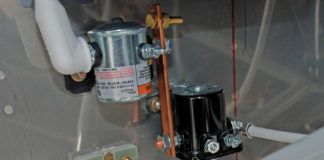When Burt Rutan unleashed the VariEze in 1970, its extremes of small size, low power and futuristic configuration marked a radical departure from the conventional aircraft of the day. Today, to see three designs at least as relatively radical (in their current setting) is a sign that general aviation may be getting a much-needed innovation infusion.
Pipistrel’s Panthera, the most conventional in appearance, benefits from the company’s long experience with motorgliders and the need to squeeze the greatest performance from the most modest of powerplants. It also helps that the electric motor scheduled for installation in two power options for the sleek five-seater was in the company’s G4 Green Flight Challenge winner.
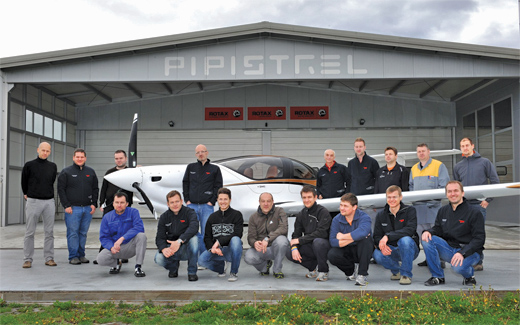
Pipistrel’s design team surrounds the new Panthera. Tine Tomazic, chief designer, is second from left, and Ivo Boscarol, company CEO, stands next to the left wingroot.
A Green Flight hopeful, John McGinnis’s Synergy, was only able to attend the competition’s Expo as a quarter-scale model, but it drew widespread interest nonetheless. A recent crowd-funding appeal pulled in more than $80,000 to help complete the prototype and pay its way to AirVenture 2013.
Coming out of the Left Coast, Paul Peterson’s Volta Volaré expands on a proven design but adds a unique serial hybrid propulsion system. The canard, an evolution of the Velocity, is now flying (in prototype form) with a Continental O-550, but it will soon acquire a pair of motors swinging counterrotating propellers and be powered by a battery pack charged by a small four-cylinder, four-stroke jet-ski engine (most likely a Yamaha SHO) driving a generator. The decoupling of generator motor and propulsion motors allows the engine to run at its most efficient speed, netting a fuel burn of only 7.4 gph at an aircraft speed of 240 mph (210 knots).
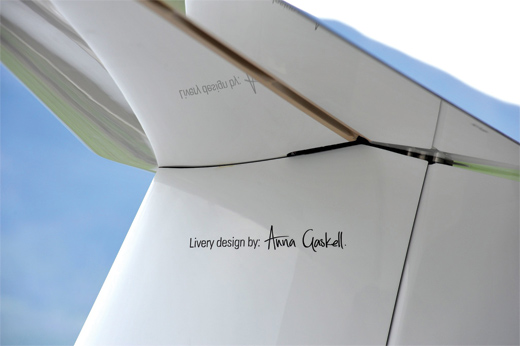
Pipistrel enlisted artists worldwide to create the new airplane’s livery with a €1000 prize. Winner Anna Gaskell’s name is reflected in the wave-free horizontal stabilizer.
All three share an economical philosophy. Synergy will fly five to seven people at an unspecified speed (exceeding 200 mph), while its DeltaHawk inverted-V engine sips around 7 gph. The Pipistrel will do 230 mph (200 knots) on 10 gph. All exceed current high-speed performance and economy of Beechcrafts, Mooneys and even Cirruses. Fuel burn for those can range from 15 to 18 gph, heady financial territory with avgas tripping over the $6-per-gallon threshold.
Their performance and economy aspirations confirmed, how do these vehicles differ in aerodynamics and power systems?
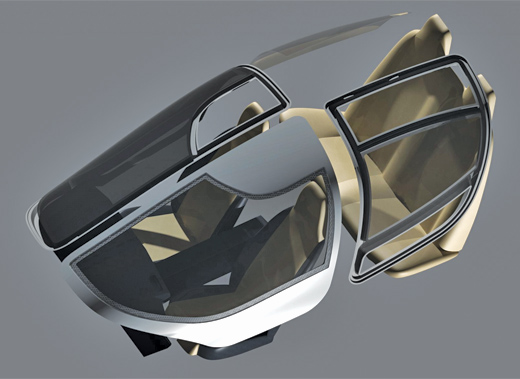
Panthera passengers are surrounded by a 26-G carbon-fiber safety cage. Those doors aren’t just for looks.
Pipistrel Panthera
Solidly defining the best of the conventional configuration, the Panthera combines high speed, comfort for up to five, and the latest in aerodynamic and systems refinement. The sleek exterior conceals a tough interior, with a 26-G safety cage cocooning its passengers and a ballistic parachute to let everyone and everything down easy, if necessary.
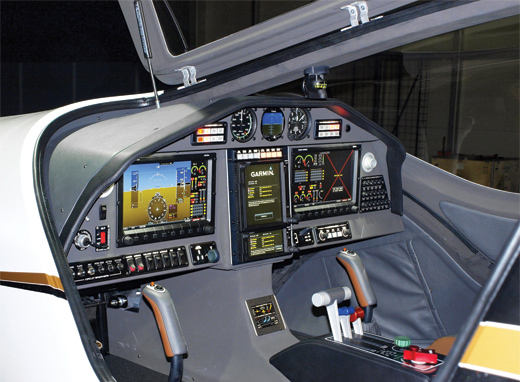
Glass panels, two steam gauges and a sailplane compass show the Panthera’s heritage and future in one sweep.
The leather seats have European style and elegance, consoling for those testing their tolerance for a 1000-mile nonstop trip—the airplane’s ostensible maximum range. Speed and range are highest for the lowest-cost, highest-performing model, and they decline, paradoxically, as more advanced power systems are installed.
Hybrid and pure electric options won’t be introduced until 2016 though, and one can only speculate as to the state of battery and motor development in the next four years. If batteries continue to grow in energy density, that progression should lead to lighter weights and greater payload for each “greener” Panthera.
Performance figures projected with today’s technology show the avgas-powered airplane able to carry 760 pounds with full fuel; the hybrid will have a usable payload of 595 pounds, and the pure electric 440. The electric versions, because they share the same 2640-pound (1200-kilogram) maximum takeoff weight, and roughly the same power as the gas version (145 kilowatts, 195 hp), have similar takeoff and climb performance.
The Lycoming IO-390 can pull the airplane off the ground in 1200 feet and clear a 50-foot barrier in 2200, while the electric versions require 1265 feet and 2300 feet. Landing distance over that 50-foot barrier is the same 1900 feet for all, making it possible to use a great many small airports.
Clearing mountains will be easier for the petrol-burning Panthera, with a service ceiling of 20,000 feet. The electrics can attain 13,000 feet. Altitude flying should be the IO-390’s forte, with its cruise of 232 mph (202 knots). The hybrid will achieve 163 mph (142 knots), and the pure electric, 136 mph (118 knots). Greater disparity is seen in maximum range. With four up and maximum fuel, the gas version manages 1025 nautical miles (1178 statute miles). The hybrid carries its smaller payload 660 nautical miles (759 statute miles), and the pure electric flies its even smaller payload 215 nautical miles (247 statute miles).
The first Pantheras will meet upcoming European emissions standards and offer a luxurious form of transport for those able to meet the $415,000 (€335,000) tariff for a kitbuilt aircraft with factory assistance. An IFR-certified, Part 23, utility-category Panthera will be $490,000 (€395,000). The hybrid version adds $74,500 (€60,000) to the base kit’s price, and the electric version adds $112,000 (€90,000).
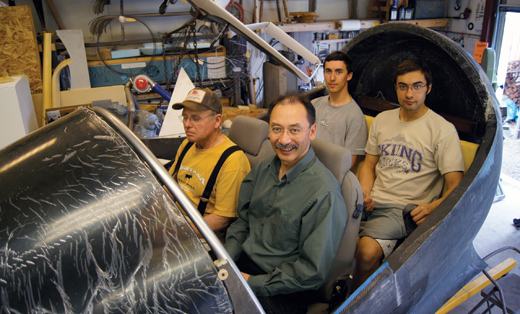
Synergy’s John McGinnis looks toward a happier future.
Synergy
At the extreme opposite end of almost every spectrum, John McGinnis’s Synergy shines a hot spotlight on the rough spots marking the conventional wisdom of aerodynamics. McGinnis kept the radical craft under wraps for several years as he established the configuration and objectives for his airplane, then astonished with its unveiling. As the web site explains, “Harmonizing six proven technologies for drag reduction at low cost, including laminar flow, wake propulsion, open thermodynamics and subsonic area ruling, Synergy achieves both high speed and low induced drag in a structurally robust, lightweight form.”
Synergy has a wingspan of 32 feet and a total wing area of 156 square feet. The five-seater (capable of carrying seven) is powered by the 200-hp DeltaHawk two-stroke, V-4 diesel engine. Sucking air ingested by the engine’s turbocharger through the cowling helps control the fuselage boundary layer and provides some pressure thrust. McGinnis avoids calling the pressure recovery/thrust scheme “Goldschmied pressure thrust” (see sidebar, Page 61), but the aggressive pressure recovery and laminar flow control, combined with drag recovered by the “wake impeller,” give additional power efficiency. Cooling air joins the exhaust in a high-speed, scavenged exit just ahead of the multi-blade prop. McGinnis hopes to gain net cooling thrust, rather than the drag normally associated with engine cooling.
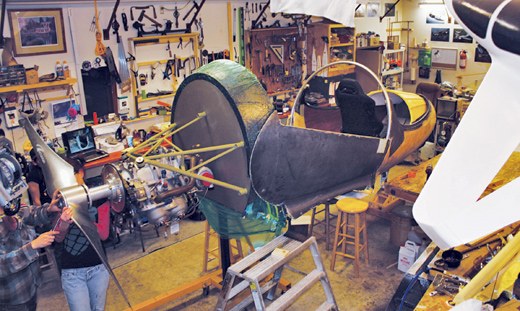
The unique shape of Synergy’s two-blade propeller reflects the uniqueness of the whole airplane. A four-blade had been planned.
His unique double-box tail is designed to recover the energy lost by wake vortices. McGinnis explained that putting airfoils in the 360° swirl of the vortex can bring benefits. “By putting large horizontal tails above and behind the wingtip, we use the force they exert against the wake vortex to provide our stability and control. It turns out that acting against induced drag this way, with about 8% of the vehicle weight, increases span efficiency to the theoretical limit. The cost of doing this at the wingtip is therefore mostly paid for, whereas on most aircraft we pay double: First we throw air at the ground, paying an induced drag penalty, then we catch some of it (right in the middle of the downwash, where we tried to move it the fastest) and pay another induced drag penalty at the tail, while we reduce the lift we just made.
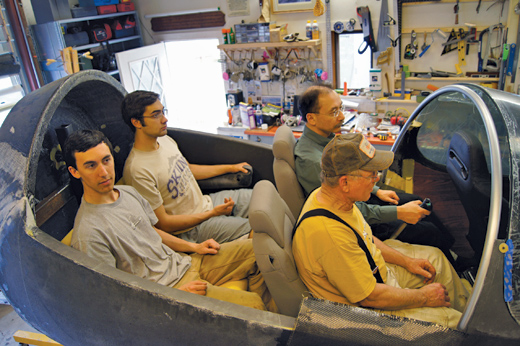
Seating and control locations in the Synergy can be moved about to suit several configurations. The cabin seats up to seven.
“But Synergy is not really about that; it’s about using the ordinary technologies we already have in a more comprehensive way. Just having a natural laminar flow fuselage would be a major change, but we’re really using all the good ideas, including both natural laminar flow throughout the aircraft and powered drag reduction through simplified boundary-layer control.”
According to McGinnis, Synergy could achieve an 80% reduction in drag over that of a traditional configuration, measured at its anticipated top speed, which is the target of much speculation. (He says he wants to publish flight-test numbers rather than unproven calculations.) His daring vision has been put back into high gear with the help of over 700 contributors to a recent kickstarter.com campaign. There is great anticipation in the aviation community to see how well the prototype lives up to its creator’s controversial dreams.
If testing reveals a worthy airframe, McGinnis says kits would follow and would eventually allow entry to the high-performance aircraft world at a relatively modest price.
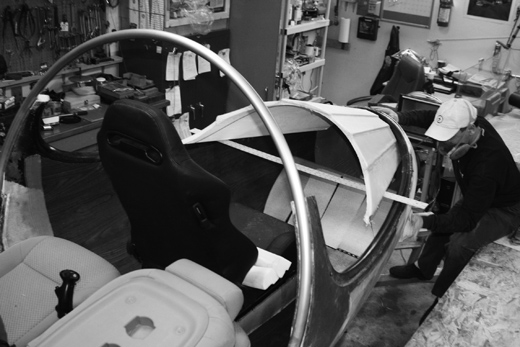
Change the seating and take four friends along with a centrally located pilot.
Volta Volaré Revisited
Somewhere between convention and revolution, the Volta Volaré, which we introduced in last month’s column, is based on a proven design, via the Velocity and its descendants. Paul Peterson, founder and CEO of the Volta Volaré and its subsidiary, Volt Aero Technologies, matched the existing airframe with his company’s EViation Drive series hybrid power system.
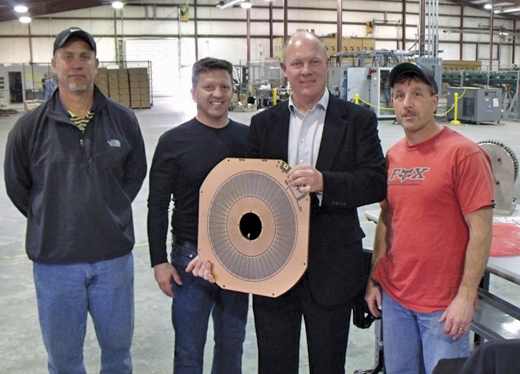
Paul Peterson holds the PCB stator alongside the CORE motor-development team. The motor is projected to develop 660 foot-pounds of torque.
The EViation Drive consists of a pair of motors powered by a large battery pack, which in turn is charged by an engine/generator system. The engine is a four-cylinder, four-stroke sports watercraft unit that turns over at 8000 rpm in its generator role. When asked about the seemingly high revs, Peterson noted the engine redlines at 14,000 rpm.
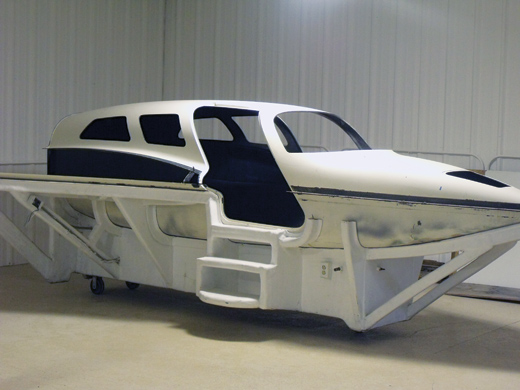
The Volta Volaré mold plug is prepared to create a female mold from which production parts will be pulled.
The motors are similar to those used on the MotoCzysz racing cycle and sold as a self-contained D1g1tal Dr1ve system. One hundred horsepower (75 kilowatts) peak power output may not sound all that exciting, but the 600 to 850 Newton-meters (442 to 627 foot-pounds) continuous torque and 800 to 1100 Newton-meters (590 to 811 foot-pounds) from this 129.8-pound (59-kilogram) unit is definitely impressive as it moves big propellers slowly. The D1D1 comes with an internal controller and gearbox, so the motor by itself is significantly lighter.
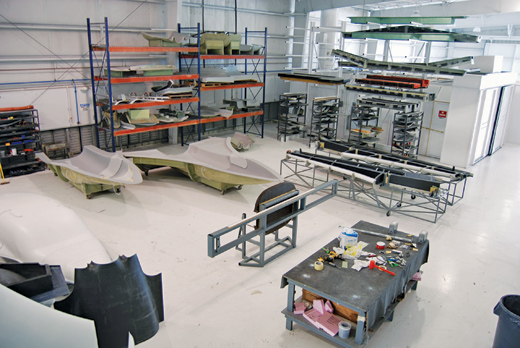
The Sebastian, Florida, Volaré builder-assistance center shows GT4 parts being staged for prospective clients. CEO Paul Peterson is scoping out BACs in other parts of the country.
A variant of this motor just drove the MotoCzysz 012-E1pc to its third Isle of Man electric Tourist Trophy win, where it also became the first electric bike to average more than 100 mph around the 37-mile, incredibly twisty circuit.
Nine hundred pounds of batteries don’t begin to fill the large strakes along the wing-fuselage intersection and also fit neatly into the CG for the aircraft. As batteries become lighter and more powerful, the airplane’s range and useful payload will increase.
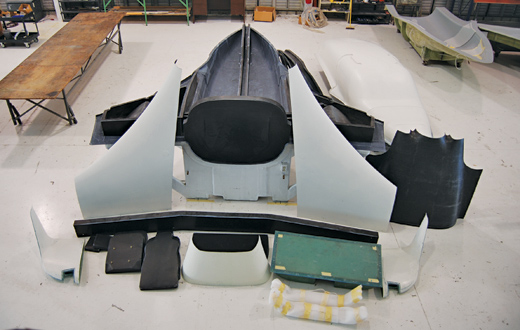
Lucky customer No. 7 will get to assemble this airplane at a BAC.
Peterson introduced his hybrid canard at this year’s Electric Aircraft Symposium in Santa Rosa, California, and, after meeting with attendees, he found that he liked the idea of using twin motors to drive two counterrotating propellers rather than ganging two motors to drive one large propeller. His motors will spin in the horizontal axis, and through a special set of differentials, will drive a pair of propellers spinning in opposite directions on the Volaré’s tail. According to Peterson, this will eliminate gyroscopic forces in yaw and roll, reduce propeller noise and increase efficiency.
Like the Panthera, Volta Volaré is a kit, but it can only be built at a builder-assistance center. Peterson has one already in Sebastian, Florida, and is scouting a location in Oregon and at least two more in the Midwest and on the East Coast. Surprisingly, the first foreign BAC will be in Dubai, an instance of willing investors insisting on jumping in.
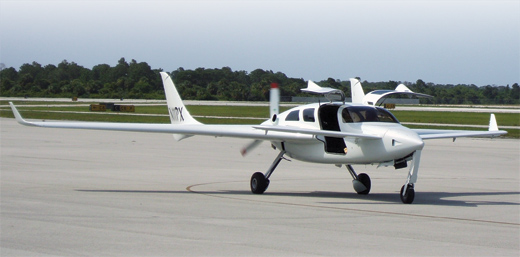
Gull wings on the Volaré open to keep cool on the runway—probably not necessary on production models, which will have AC.

This dramatic head-on view highlights the clean lines of Volta Volaré.
The airplane’s $495,000 price includes expert assistance and guidance in a BAC, the EViation power system and batteries, but some assembly is required, Peterson said with a smile. Volta Volaré is looking at destination locations for these centers, with excellent hotels, restaurants, shopping and tourist attractions to help make the two-week build a family experience.
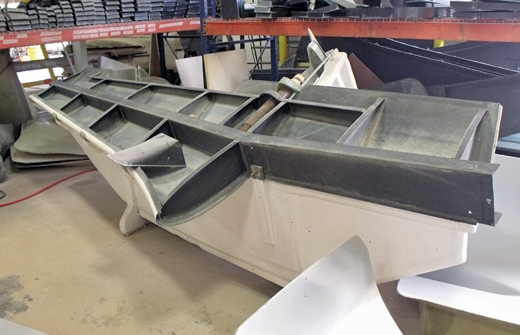
A thick spar, which fits into large fuselage strakes, provides ample battery and luggage room in the Volaré.

The next-generation EViation Drive will include a powerful new motor that uses a printed circuit-board stator.
Looking Forward
Each of these airplanes is a marvel of the aeronautical arts, and as their unique power systems get sorted out, they may come to point the way for general aviation’s future. One of the good things about hybrid and electric powerplants is that they are scalable, so we might see many of these advances in ultralights, motorgliders and Light Sport Aircraft, making them more reliable, less costly to operate and quieter, better neighbors.
McGinnis is furthest from marketing Synergy, but Peterson and Pipistrel have orders for several of their cruisers. The future grows nearer.

![]()
Dean Sigler has been a technical writer for 30 years, with a liberal arts background and a Master’s degree in education. He writes the CAFE Foundation blog and has spoken at the last two Electric Aircraft Symposia and at two Experimental Soaring Association workshops. Part of the Perlan Project, he is a private pilot, and hopes to get a sailplane rating soon.

